
Soursop is the fruit of Annona muricata, a broadleaf, flowering, evergreen tree. It is native to the tropical regions of the Americas and the Caribbean and is widely propagated. It is in the same genus, Annona, as cherimoya and is in the Annonaceae family.

Lycium is a genus of flowering plants in the nightshade family, Solanaceae. The genus has a disjunct distribution around the globe, with species occurring on most continents in temperate and subtropical regions. South America has the most species, followed by North America and southern Africa. There are several scattered across Europe and Asia, and one is native to Australia. Common English names for plants of this genus include goji berry, box-thorn and desert-thorn.

Lycium barbarum is a shrub native to China, with present-day range across Asia and southeast Europe. It is one of two species of boxthorn in the family Solanaceae from which the goji berry or wolfberry is harvested, the other being Lycium chinense.
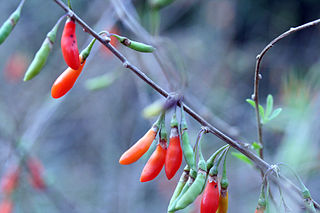
Lycium chinense is one of two species of boxthorn shrub in the family Solanaceae. Along with Lycium barbarum, it produces the goji berry ("wolfberry"). Two varieties are recognized, L. chinense var. chinense and L. chinense var. potaninii. It is also known as Chinese boxthorn, Chinese matrimony-vine, Chinese teaplant, Chinese wolfberry, wolfberry, and Chinese desert-thorn.

Doryanthes excelsa, commonly known as the gymea lily, is a flowering plant in the family Doryanthaceae that is endemic to coastal areas of New South Wales near Sydney. It has sword-like leaves more than 1 metre (3 ft) long and it grows a flower spike up to 6 metres (20 ft) high. The apex of the spike bears a large cluster of bright red flowers, each 10 centimetres (4 in) across. Its common name is derived from the name given to the plant by the indigenous [Dharawal] people. The Sydney suburbs of Gymea and Gymea Bay are named after the lily.

Banksia serrata, commonly known as the saw banksia, the old man banksia, the saw-tooth banksia or the red honeysuckle and as wiriyagan by the Cadigal people, is a species of woody shrub or tree of the genus Banksia, in the family Proteaceae. Native to the east coast of Australia, it is found from Queensland to Victoria with outlying populations on Tasmania and Flinders Island. Commonly growing as a gnarled tree up to 16 m (50 ft) in height, it can be much smaller in more exposed areas. This Banksia species has wrinkled grey bark, shiny dark green serrated leaves and large yellow or greyish-yellow flower spikes appearing over summer. The flower spikes, or inflorescences, turn grey as they age and pollinated flowers develop into large, grey, woody seed pods called follicles.

Acer glabrum is a species of maple native to western North America, from southeastern Alaska, British Columbia and western Alberta, east to western Nebraska, and south through Washington, Oregon, Idaho, Montana and Colorado to California, Arizona, Utah, and New Mexico.

Ipomoea indica is a species of flowering plant in the family Convolvulaceae, known by several common names, including blue morning glory, oceanblue morning glory, koali awa, and blue dawn flower. It bears heart-shaped or three-lobed leaves and purple or blue funnel-shaped flowers 6–8 cm (2–3 in) in diameter, from spring to autumn. The flowers produced by the plant are hermaphroditic. This plant has gained the Royal Horticultural Society's Award of Garden Merit.

Lycium californicum is a spreading shrub in the nightshade family known by the common names California boxthorn and California desert-thorn.

Lycium andersonii is a species of flowering plant in the nightshade family, Solanaceae. Its common names include water-jacket, redberry desert-thorn, Anderson thornbush, Anderson's desert thorn, Anderson boxthorn, Anderson lycium, Anderson wolfberry, and squawberry.

Lycium ferocissimum, the African boxthorn or boxthorn, is a shrub in the nightshade family (Solanaceae) indigenous to South Africa.

Lycium brevipes is a species of flowering plant in the nightshade family known by the common name Baja desert-thorn. It is native to northwestern Mexico and it occurs in California as far as the Sonoran Desert as well as some of the Channel Islands. It grows in the scrub of desert and coastline. It is also used as a southwestern landscaping plant. This is a bushy, spreading shrub approaching a maximum height of 4 metres (13 ft) with many long, thorny, tangled branches. The branches are lined with small, fleshy green leaves up to 1.5 centimetres (0.59 in) long and coated with glandular hairs. The inflorescence is a small cluster of tubular flowers roughly 1–2 centimetres (0.39–0.79 in) long including the calyx of sepals at the base. The lavender to nearly white corolla is funnel-shaped and has 2 to 6 lobes at the mouth. The five stamens and one style protrude from the flower. The fruit is a bright red spherical berry about a centimeter wide containing many seeds. The berries attract birds.

Lycium cooperi is a species of flowering plant in the nightshade family known by the common name peach thorn. It is native to the southwestern United States, where it grows in a variety of desert and mountain habitat types. This is a bushy, erect shrub approaching a maximum height of 4 metres (13 ft) with many rigid, thorny branches. The branches are lined thickly with fleshy oval or widely lance-shaped leaves each 1–3 centimetres (0.39–1.18 in) long and coated with glandular hairs. The inflorescence is a small cluster of tubular flowers roughly 1–2 centimetres (0.39–0.79 in) long including the calyx of fleshy sepals at the base. The flower is white or greenish with lavender or green veining. The corolla is a tube opening into a face with four or five lobes. The fruit is a yellow or orange berry under a centimeter wide containing many seeds.
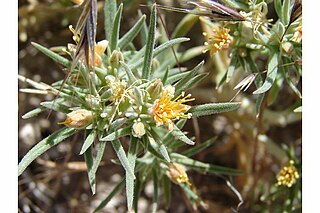
Mentzelia torreyi is a species of flowering plant in the family Loasaceae known by the common name Torrey's blazingstar. It is native to the western United States where it grows in the Great Basin and surrounding areas in desert, scrub, woodland, and other habitat.
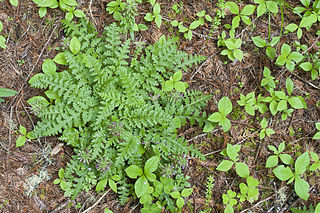
Pedicularis dudleyi is a rare species of flowering plant in the family Orobanchaceae known by the common name Dudley's lousewort. It is endemic to central California, where it is known from about ten scattered occurrences along the coast and in the coastal mountain ranges. It has been found in three locations along the Central California coast. The species was named for 19th-century Stanford University botanist William Dudley.
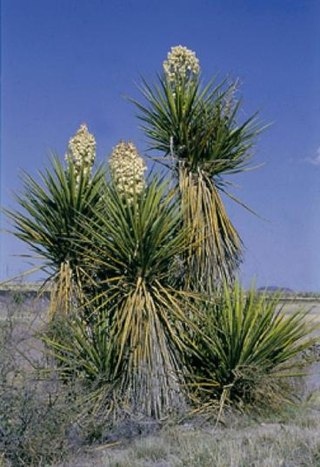
Yucca faxoniana is a bladed evergreen shrub of the genus Yucca. It is known by the common names Faxon yucca,Spanish dagger, and giant dagger.

Lycium berlandieri is a species of flowering plant in the nightshade family known by the common name Berlandier's wolfberry. It is native to Mexico and the south-western United States from Arizona to Texas.

Lycium pallidum is a species of flowering plant in the nightshade family known by the common names pale wolfberry and pale desert-thorn. It is native to northern Mexico and the southwestern United States. In Mexico it can be found in Sonora, Chihuahua, Zacatecas, and San Luis Potosi. In the United States it occurs from California to Texas and as far north as Utah and Colorado.
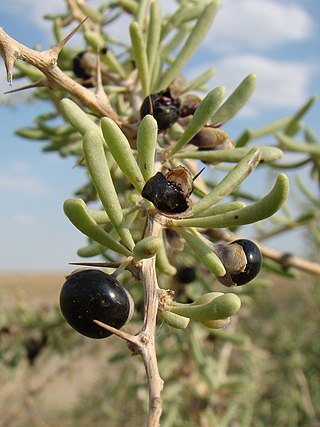
Lycium ruthenicum, is a flowering plant commonly known as Russian box thorn in the West. is a species of flowering plant in the nightshade family which can be found in Central Asia, southern part of Russia, throughout Northwest China, Northern India and Pakistan. Also commonly known as black fruit wolfberry, siyah goji, and kaokee.



















